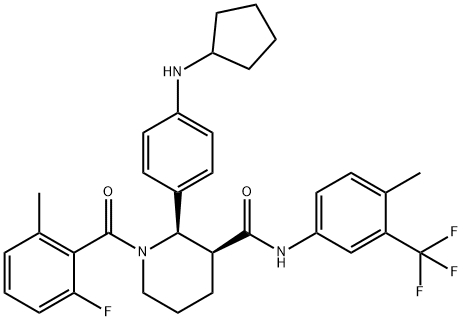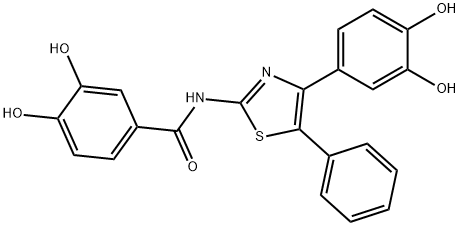Budiodarone tartrate
- CAS NO.:1346623-17-3
- Empirical Formula: C33H35F4N3O2
- Molecular Weight: 581.64
- MDL number: MFCD28502293
- SAFETY DATA SHEET (SDS)
- Update Date: 2025-10-29 15:43:00

What is Budiodarone tartrate?
Absorption
In AAV patients receiving 30 mg avacopan twice daily, avacopan had a Cmax of 349 ± 169 ng/mL and an AUC0-12hr of 3466 ± 1921 ng*h/mL. On this dosing scheme, steady-state plasma concentrations are reached by 13 weeks with a roughly 4-fold accumulation. Co-administration of 30 mg with a high-fat meal increased the Cmax by ~8%, the AUC by ~72%, and delayed the Tmax by four hours (from two hours).
Toxicity
Animal studies have not revealed any mutagenic potential of avacopan and no impairment of fertility at doses up to 1000 mg/kg/day. Avacopan is not mutagenic based on the Ames test.
Background
Anti-neutrophil cytoplasmic (auto)antibody (ANCA)-associated vasculitis (AAV) is a rare (estimated incidence of 3 cases per 100,000 per year) form of "pauci-immune" systemic small-vessel vasculitis typified by the presence of ANCAs in the serum. The full spectrum of AAV includes granulomatosis with polyangiitis (GPA), microscopic polyangiitis (MPA), eosinophilic granulomatosis with polyangiitis (EGPA), and drug-induced AAV. AAV may be associated with necrotizing and crescentic glomerulonephritis (NCGN). Despite complex pathophysiology, studies over the past ~2 decades have identified a key role for the alternative complement pathway and, in particular, the interaction between the anaphylatoxin fragment C5a and its cognate C5aR receptor in AAV. Avacopan (formerly CCX168) is an allosteric C5aR antagonist indicated for use in AAV.
Avacopan was granted FDA approval on October 8, 2021, and is currently marketed under the name TAVNEOS by ChemoCentryx, Inc. On January 19, 2022, the European Commission approved avacopan for the treatment of adult patients with severe, active granulomatosis polyangiitis (GPA) or microscopic polyangiitis (MPA) - the two main forms of ANCA-associated vasculitis - in combination with rituximab or cyclophosphamide. Avacopan was approved by Health Canada on April 20, 2022.
Indications
Avacopan is indicated for the adjunctive treatment of adult patients with severe active anti-neutrophil cytoplasmic autoantibody (ANCA)-associated vasculitis (granulomatosis with polyangiitis and microscopic polyangiitis; GPA/MPA) in combination with standard therapy including glucocorticoids. Avacopan does not eliminate the need for glucocorticoids.
In Europe, avacopan is approved for the treatment of adults with severe, active granulomatosis polyangiitis (GPA) or microscopic polyangiitis (MPA) in combination with rituximab or cyclophosphamide.
Pharmacokinetics
Avacopan is a complement 5a receptor (C5aR) antagonist that blocks C5a-induced upregulation of C11b (integrin alpha M) on neutrophils and inhibits C5a-mediated neutrophil activation and migration. Avacopan has been associated with hypersensitivity reactions, including angioedema, and hepatotoxicity, as evidenced by elevated liver transaminases. Likely due to its effect on the complement pathway, avacopan has also been associated with hepatitis B virus reactivation and serious infections, which should be monitored for as appropriate.
Metabolism
Avacopan is metabolized primarily by CYP3A4. The major circulating M1 metabolite, a mono-hydroxylated form of avacopan, represents ~12% of drug plasma levels and acts as a C5aR antagonist with similar efficacy to avacopan itself.
Properties of Budiodarone tartrate
| Boiling point: | 730.7±60.0 °C(Predicted) |
| Density | 1.287±0.06 g/cm3(Predicted) |
| solubility | DMF: 12 mg/ml; DMSO: 5 mg/ml; Ethanol: 3 mg/ml |
| form | A solid |
| pka | 14.02±0.70(Predicted) |
| color | White to off-white |
Safety information for Budiodarone tartrate
Computed Descriptors for Budiodarone tartrate
New Products
4,4-Difluoropiperidine hydrochloride tert-butyl 9-methoxy-3-azaspiro[5.5]undecane-3-carboxylate Indole Methyl Resin N-Isopropylurea N,N-Dicyclohexylcarbodiimide(DCC) MELDRUMS ACID 5-METHYLISOXAZOLE-4-CARBOXYLIC ACID Magnessium Bis glycinate Zinc ascorbate 1-bromo-2-butyne 2-acetamidophenol 9(10H)-anthracenone Erythrosin B, 4-Piperidinopiperidine 2-((4-morpholinophenylamino) (methylthio) methylene) malononitrile 2,4-dihydroxybenzaldehyde 3-(4-morpholinophenylamino)-5-amino-1H-pyrazole-4-carbonitrile Methyl 2-methylquinoline-6-carboxylate 2,6-dichloro-4-nitropyridine 4-Bromo-2-chlorobenzonitrile 2-(benzylamino)acetic acid hydrochloride 4-(tert-Butoxycarbonylamino)but- 2-ynoic acid 3,4-dihydro-2H-benzo[b][1,4]dioxepine 1-Phenyl-1-cycloprppanecarboxylicacidRelated products of tetrahydrofuran





![1-((2S,5R)-5-((7H-pyrrolo[2,3-d]pyrimidin-4-yl)amino)-2-methylpiperidin-1-yl)prop-2-en-1-one](https://img.chemicalbook.in/CAS/20180702/GIF/1792180-81-4.gif)


You may like
-
 3-(4-amino-1-oxoisoindolin-2-yl)-1-methylpiperidine-2,6-dione 98%View Details
3-(4-amino-1-oxoisoindolin-2-yl)-1-methylpiperidine-2,6-dione 98%View Details -
 1-methylindoline-2,3-dione 98%View Details
1-methylindoline-2,3-dione 98%View Details
2058-74-4 -
 614-19-7 98%View Details
614-19-7 98%View Details
614-19-7 -
 3112-85-4 Methyl phenyl sulfone 98%View Details
3112-85-4 Methyl phenyl sulfone 98%View Details
3112-85-4 -
 20677-73-0 (2,2-diethoxyethyl)methylamine 98%View Details
20677-73-0 (2,2-diethoxyethyl)methylamine 98%View Details
20677-73-0 -
 3-(4-(hydroxyamino)-1-oxoisoindolin-2-yl)piperidine-2,6-dione 98%View Details
3-(4-(hydroxyamino)-1-oxoisoindolin-2-yl)piperidine-2,6-dione 98%View Details -
 57381-49-4 2-bromo-4-chlorobenzonitrile 98%View Details
57381-49-4 2-bromo-4-chlorobenzonitrile 98%View Details
57381-49-4 -
 4,6-dichloropyrimidine-5-carbaldehyde 98%View Details
4,6-dichloropyrimidine-5-carbaldehyde 98%View Details
5305-40-8
